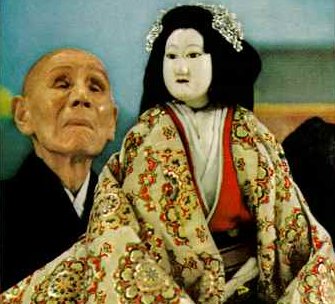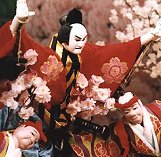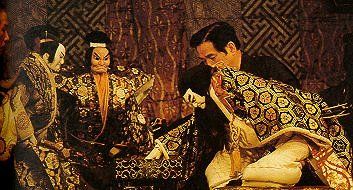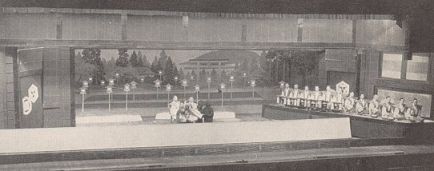
Bunraku
Bunraku is a traditional Japanese puppet theater. It is performed by a team which consists of a narrator, a shamisen player and puppets, each puppet being manipulated by three puppeteers.
History
During the 9th to the 12th century there were traveling puppet-show operators called kugutsu mawashi. By the end of the 12th century some of the troupes became installed in shrines and temples.
Concurrently, Buddhist priests and blind musicians performed passages from historical romances, accompanied by the biwa, which was a four-stringed plucked instrument shaped like the mandolin. In the middle of the 15th century an extremely popular romance The Tale of Joruri appeared. The samisen, a three-stringed instrument, replaced the biwa in performances since it was more suited to the drama of the Tale.
The first puppet performance of the story was in 1596 in Kyoto. Puppeteers traveled from there to Edo in 1616 and the center of the doll theater shifted to Osaka.
Major success was largely due to two individuals. One was Chikamatsu Mozaemon (1653-1725), the first actual professional playwright in Japan. The other person was Takemoto Gidayu (1651-1714), an accomplished performer. The Takemoto Theater, a joint effort on their part, was opened in 1684.
The first puppets were relatively crude clay figures; these evolved into hand-operated puppets around 1690. The present-day doll came about around 1736.
Bunraku's popularity increased, then began to decline since the 18th century and it is unlikely to ever again attain the high levels of popularity it once had.
Like other forms of popular entertainment, Bunraku was also subject to government restrictions. In 1703, for example, the government forbid the dramatization of current events, and it did not want plays in which the warrior class might be held up to ridicule.
The doll operators
The omozukai is the most important of the three puppeteers, supporting the puppet's body and moving the head and right arm. The hidanzukai moves the left arm and props. The third, the ashizukai, controls the movement of the legs. There is also a narrator who describes the action and speaks all the parts, maybe as many as eleven characters in one scene! The plots might be taken from ancient heroes or famous incidents but they can also concern basically everyday life.

A person starts by studying the art of ashizukai for around 10 years. Then the hidanzukai is studied, which takes another 10 years of training. To master the omozukai takes an entire lifetime.
One thing American audiences would find difficult is that fact that the people controlling the puppets are right out in the open, totally visible (only the master manipulator's face is visible, though. The other two faces are covered.) We are used to puppets that are controlled from under the stage or remote controlled, seemingly moving entirely of their own.
Japanese audiences, though, are not bothered by the puppeteers. The performances themselves can be very elaborate, the movement of the puppets very precise even to the point of simulating running. In one part of one play, for example, one puppet gets into a sword fight with two others splitting the skull of one open.


Below is a picture of a typical Bunraku stage.

Other Sources
Bunraku
Main Index
Japan main page
Japanese-American Internment Camps index page
Japan and World War II index page
|